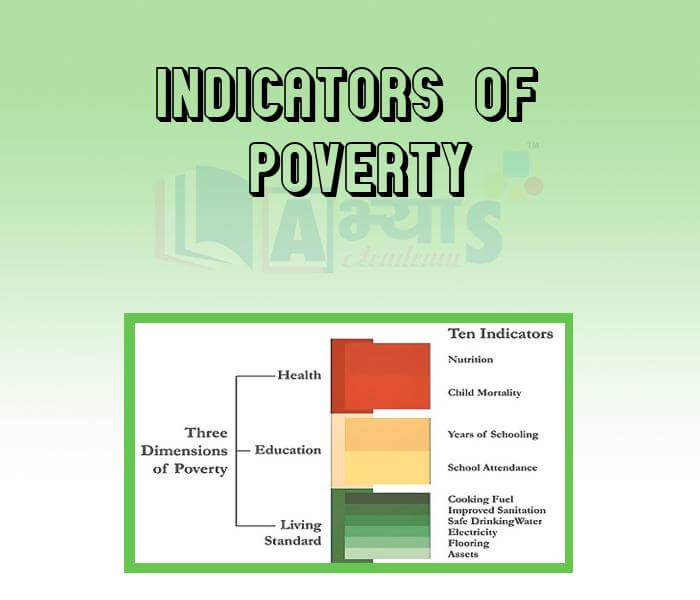Indicators of Poverty










Indicators of Poverty
Poverty
The concept of Poverty Line was first introduced in 1945 by Lord Boyd Orr, the first Director of the Food and Agriculture Organization (FAO) of the United Nations. Dr. Oar considered a person consuming less than 2300 calories per person per day. Poverty is used in two ways.
(i) Absolute Poverty - According to it, poverty is a Situation in which a person is not able to meet his minimum basic needs like food, clothes, health, convenience etc.
(ii) Relative Poverty refers to inequality of income It gives a sense of international economic inequality or regional economic inequalities. For example, if the per capita income of one country is less than the per capita income of another country, then the first country will be considered poorer than the other country.
Planning Commission in India has emphasized the Absolute Concept of Poverty. The Planning Commission has considered calorie energy as the basis of the poverty line.nThere are two grounds for measuring poverty in India
Students / Parents Reviews [10]
It was good as the experience because as we had come here we had been improved in a such envirnment created here.Extra is taught which is beneficial for future.

Eshan Arora
8thOne of the best institutes to develope a child interest in studies.Provides SST and English knowledge also unlike other institutes. Teachers are co operative and friendly online tests andPPT develope practical knowledge also.

Aman Kumar Shrivastava
10thAbhyas Methodology is very good. It is based on according to student and each child manages accordingly to its properly. Methodology has improved the abilities of students to shine them in future.

Manish Kumar
10thMy experience was very good with Abhyas academy. I am studying here from 6th class and I am satisfied by its results in my life. I improved a lot here ahead of school syllabus.

Ayan Ghosh
8thMy experience with Abhyas is very good. I have learnt many things here like vedic maths and reasoning also. Teachers here first take our doubts and then there are assignments to verify our weak points.

Shivam Rana
7thMy experience with Abhyas academy is very good. I did not think that my every subject coming here will be so strong. The main thing is that the online tests had made me learn here more things.

Hiya Gupta
8thBeing a parent, I saw my daughter improvement in her studies by seeing a good result in all day to day compititive exam TMO, NSO, IEO etc and as well as studies. I have got a fruitful result from my daughter.

Prisha Gupta
8thIt has a great methodology. Students here can get analysis to their test quickly.We can learn easily through PPTs and the testing methods are good. We know that where we have to practice

Barkha Arora
10thAbhyas is a complete education Institute. Here extreme care is taken by teacher with the help of regular exam. Extra classes also conducted by the institute, if the student is weak.

Om Umang
10thAbout Abhyas metholodology the teachers are very nice and hardworking toward students.The Centre Head Mrs Anu Sethi is also a brilliant teacher.Abhyas has taught me how to overcome problems and has always taken my doubts and suppoeted me.
